MARIANI’S
Virtual Gourmet
November
2, 2014
NEWSLETTER

❖❖❖
IN THIS ISSUE
BOSTON'S MOOO. . . GREAT BEEF IN BACK BAY
By Christopher Mariani
NEW YORK CORNER
IL MULINO PRIME
By John Mariani
NOTES FROM THE WINE CELLAR
NEW MEXICAN SPARKLER
By Andrew Chalk
❖❖❖
BOSTON'S MOOO. . .
SERVES GREAT BEEF IN BACK BAY
By Christopher Mariani
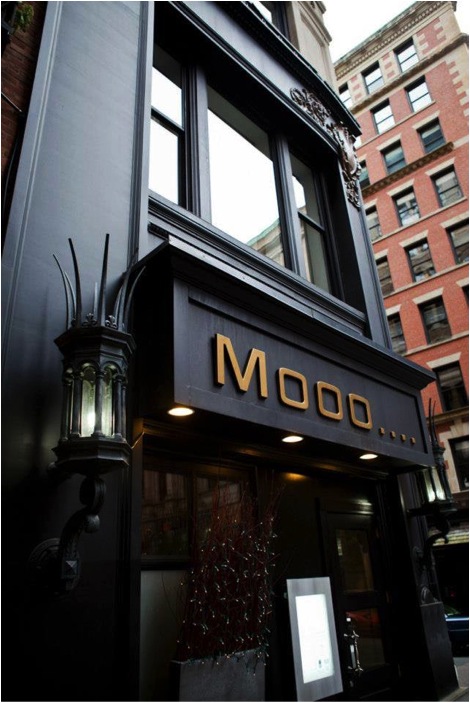 After
dining around town at some new places, my
last meal in Boston before heading home to New
York on a fall weekend turned out to the best of
the entire weekend. We had packed the car and
driven downtown to Beacon Street for brunch at
Mooo, located adjacent to XV Beacon,
one of Boston’s premiere hotels. The restaurant,
after a couple of mutations, is now
well-established, excelling as a modern day
steakhouse with a stellar wine list, impeccable
service staff and one the best brunch menus I’ve
ever seen.
After
dining around town at some new places, my
last meal in Boston before heading home to New
York on a fall weekend turned out to the best of
the entire weekend. We had packed the car and
driven downtown to Beacon Street for brunch at
Mooo, located adjacent to XV Beacon,
one of Boston’s premiere hotels. The restaurant,
after a couple of mutations, is now
well-established, excelling as a modern day
steakhouse with a stellar wine list, impeccable
service staff and one the best brunch menus I’ve
ever seen.
XV Beacon occupies the site of
what was once the Bromfield Mansion, built in 1722
by Boston merchant Edward Bromfield; the present
building was replaced in 1903. Designed by Boston
architect William Gibbons Preston, who also did the
city’s Museum of Natural History in Back
Bay and the International Trust Company Building,
the new edifice served an array of functions over the
years, as the Boston Transit Commission
(1905), the Rapid Transit Commission (1906), The Boston
School Committee (1923-99), and then as the
posh 60-room hotel it is today, retaining all the
building’s stunning Beaux Arts design.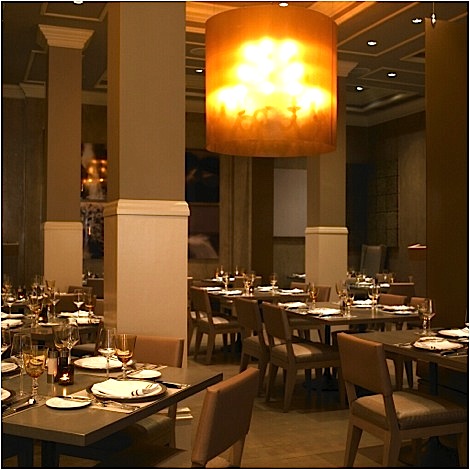
Originally the restaurant here
was called The Federalist, featuring contemporary
New England cuisine.
Then in 2007 Chef Jamie Mammano, who also
runs several of Boston’s best restaurants, including
the very fine Mistral, changed it into Mooo. . .,
primarily as a steakhouse, but you will still find
several New England specialties on the menu, not
least lobsters in many forms. Executive chef David
Hutton is at the helm here, having worked with
Mammano at Mistral.
Upon entering,
we found the restaurant screamed elegance, with an
air of sophistication, simple lines and a soft
beauty that is as welcoming to women as men—not
always the case in steakhouses. Large, throne-like
seats surround some of the VIP tables, while soft
beige tones blanket the entire space. High-ceilings
with broad white moldings display massive
cylindrical chandeliers that delicately light the
grand dining room. The service pieces, glassware and
table displays exemplify the vision and standards
set by general manager Alexa Demarco. Servers
are as cordial as any successful restaurateur and
his guests could
hope for. Their food knowledge and service mechanics
are clearly the result of meticulous training and
practice.
The beef-centric dinner menu
incorporates excellent cuts of porterhouse,
filet mignon, sirloins, dry-aged rib eyes, along
with a Japanese Wagyu sirloin, all served with
roasted garlic and bone marrow butter. The dinner menu also lists Maine
lobster bisque, grilled
Faroe Island salmon with more lobster, and
skillet-roasted Cornish game hen.
I did not have the opportunity to eat here for
dinner, but, based on my steak and eggs Wellington
at brunch, I can attest that Moo. . .’s steaks are
top-notch. We started off with two glasses of
freshly squeezed orange juice and two hot coffees,
served within moments
of our arrival. After we briefly reviewed the brunch
menu, our server approached us and recommended the
beignets. We happily accepted the suggestion, and
soon after, a tall pile of piping hot beignets came
right from the fryer, lightly coated with sweet
sugar and cinnamon, filled with a deep purple
blueberry puree that oozed out from the sides. We
could have easily ordered another plate of them and
refilled our coffee cups with great satisfaction,
but we decided to explore the entrée options.
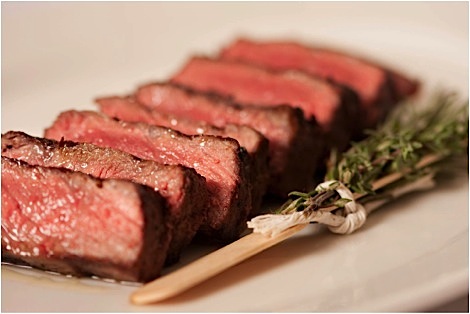 Two filet mignons that
appeared to be six-ounce each sat on top of
buttery puff pastry, topped with thick slabs of
seared foie gras, sided by sautéed spinach and a
rich brown jus
that soaked into the pastry. Presentation and the
high quality of ingredients is what made for a very
memorable beef Wellington. I was unable to finish
the dish but had no remorse paying $32 for this
brunch feast. We also shared an omelet, slow-cooked
at a low heat with butter, filled with sautéed
spinach and cheese. The right proportions were used,
and it was easy to detect that the eggs were cooked
with lots of care, with not a millimeter of the
omelet burned. There are also selections of raw
oysters, corned beef hash, Wagyu steak frites and
Belgium waffles.
Two filet mignons that
appeared to be six-ounce each sat on top of
buttery puff pastry, topped with thick slabs of
seared foie gras, sided by sautéed spinach and a
rich brown jus
that soaked into the pastry. Presentation and the
high quality of ingredients is what made for a very
memorable beef Wellington. I was unable to finish
the dish but had no remorse paying $32 for this
brunch feast. We also shared an omelet, slow-cooked
at a low heat with butter, filled with sautéed
spinach and cheese. The right proportions were used,
and it was easy to detect that the eggs were cooked
with lots of care, with not a millimeter of the
omelet burned. There are also selections of raw
oysters, corned beef hash, Wagyu steak frites and
Belgium waffles.
It is one thing to offer terrific
service or exemplary food and even an outstanding
décor; but to bring all three elements together is
what makes for a truly great restaurant, and that is
exactly what Moo. . . is achieving. The entire
team cuts no corners and it pays off
handsomely. I
am delighted to see such craftsmanship and attention
to detail during a time when so many restaurants are
deviating from the very foundations of American
hospitality.
The granite foundation of
downstairs Wine Cellar has a double-vaulted ceiling;
a caged-glass walls hold wines ranging from today’s
notables to the most obscure “cult wines,” as well
as a notable collection of rare Cognacs and
Scotches. This cellar is used as the
functioning wine cellar for Mooo… and as a private
dining room for those who seek intimacy or
seclusion.
Boston has
only two first-rate indigenous steakhouses--the
classic Grill 23
and the Italian style Davio’s, as well
as all the usual outsider chains. But for
me, Mooo. . . , despite a name that’s way too cute,
delivers a casual elegance that fits right into the
neighborhood of Beacon Hill.
❖❖❖
By John Mariani
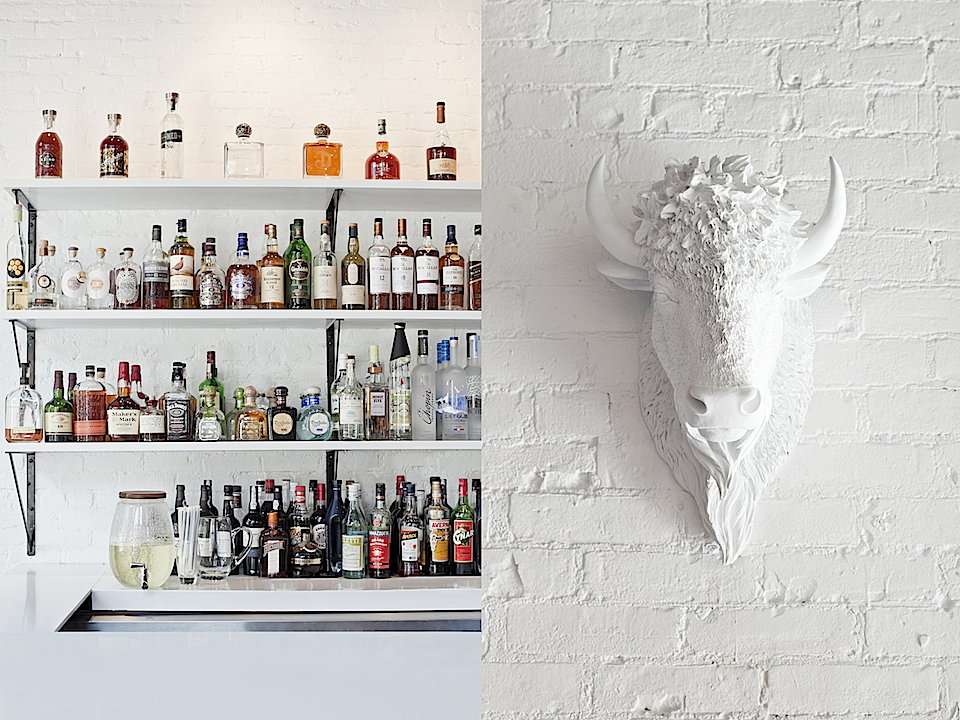 IL MULINO
PRIME
IL MULINO
PRIME331 West Broadway
212-226-0020
ilmulinoprime.com
At a moment when
there have never been so many new steakhouses in
NYC—Davio’s, NYY Steak, Angus Club, Charlie
Palmer’s, Strip House Midtown, American Cut, and
the re-opened Gallagher’s, all this year—the
classic Italian restaurant Il Mulino is tossing
its hat in the ring and doing so with a good bit
of modern dash for such a conservative genre.
For one thing, Il Mulino Prime is down in
SoHo and for another its décor is as far from the
macho look of most other beef emporiums around
town. It’s a pretty small room, too, with just 50
seats and six at the bar. Neither does it look
like the original Il Mulino in Greenwich Village
and its newer sibling in midtown.
Over three decades, Il Mulino was the
ultimate expense account Italian restaurant, the
place New York businessmen took their out-of-town
clients; the place where Barack Obama and Bill
Clinton chewed the rag for lunch in NYC; the place
famous for setting 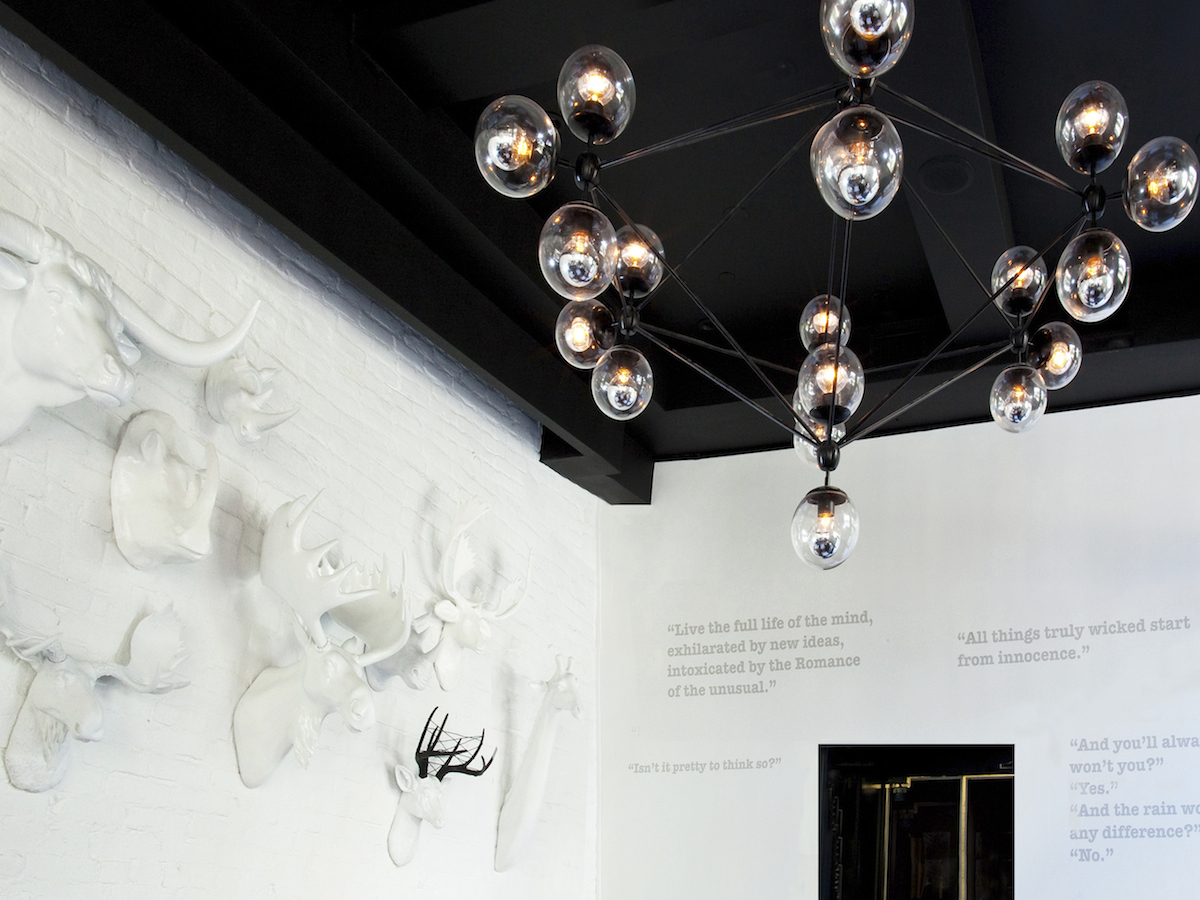 out
complimentary dishes of Parmigiano, sausage, and
other antipasti;
and, not least, one of the most expensive Italian
restaurants in America.
out
complimentary dishes of Parmigiano, sausage, and
other antipasti;
and, not least, one of the most expensive Italian
restaurants in America.
In
2001 Brian
Galligan and his partner Jerry Katzoff bought Il
Mulino from brothers Fernando and Gino Masci,
and soon
planned out an expansion of the brand, from New
York to Las Vegas and Tokyo. Il
Mulino Prime is their first steakhouse, and,
I suspect, the prototype for others to follow.
I like the fresh, white look of the place
and the congenial greeting. A painted buffalo head
and other antlers hang on brightly lighted brick
walls. The black ceiling is hung with clear glass
globe lamps and a rear wall is stenciled with
observations by littérateurs (right) like
Ernest Hemingway,
including the last line from The Sun Also
Rises: “Isn’t it pretty to think so.” None
has much to do with eating at a steakhouse, but
it’s fun to try to guess the sources.
The clientele seems a mix of beefy guys
from the finance sector and casually dressed
locals out for a splurge.
The menu is a mix of Il Mulino favorites
from the past 30 years, along with all the
requisite chophouse items. Prices
certainly match any of the midtown steakhouses,
with chopped steak at $36, an 18-ounce ribeye at
$48, and a one-kilogram—that’s more than two
pounds--porterhouse at $125. (A similar rendering
of côte de boeuf at Minetta Tavern runs $145.)
Jumbo lump crabmeat ($24) lived up to its
weight class, as did jumbo shrimp ($28), but I
encourage your table to share a platter of
excellent beefsteak tomatoes and buffalo
mozzarella ($24), provided the kitchen can still
get tomatoes at this season of a kind I had at the
end of summer.
 The
“Modern
Italian Classics” section lists a lobster
mac-and-cheese, the mac in question being fusilli
($32), a pricey dish, but a very good one. Run-of-the-mill
linguine with white clam sauce at $32 was not
worth the money.
What’s not to like about short ribs ravioli
(left)
with mushrooms and black truffles in cream (and
the white truffles are coming in right now)?
The
“Modern
Italian Classics” section lists a lobster
mac-and-cheese, the mac in question being fusilli
($32), a pricey dish, but a very good one. Run-of-the-mill
linguine with white clam sauce at $32 was not
worth the money.
What’s not to like about short ribs ravioli
(left)
with mushrooms and black truffles in cream (and
the white truffles are coming in right now)?
A veal chop parmigiana ($45) was easily as
big and a whole lot better than the notorious $50
version at Carbone.
“English Dover sole” (market price) is a
redundancy, but it was a delicious, well-fatted
fish with a nice tangy meunière sauce.
The beef is all dry aged USDA Prime, some,
like the American Kobe ($60) and the bison ribeye
($54), served off the bone; the fine 16-ounce New
York strip ($50) is an excellent piece of beef in
every respect, with a robust aged flavor and good
chew. Odd
then that the ribeye ($48), a juicier part
of the steer, didn’t seem to hit the plate at the
advertized 18 ounces and was cut in a puzzlingly
thin slab. When
I asked the chef about that, he said I could ask
for it thicker—but how would I know until it
arrived?
As the photo of the ribeye shows (below), the
steaks get the grill marks treatment, but overall
the exterior lacks a real, overall char. Next
time I’ll ask for it “Pittsburgh,” steakhouse
slang for black outside, 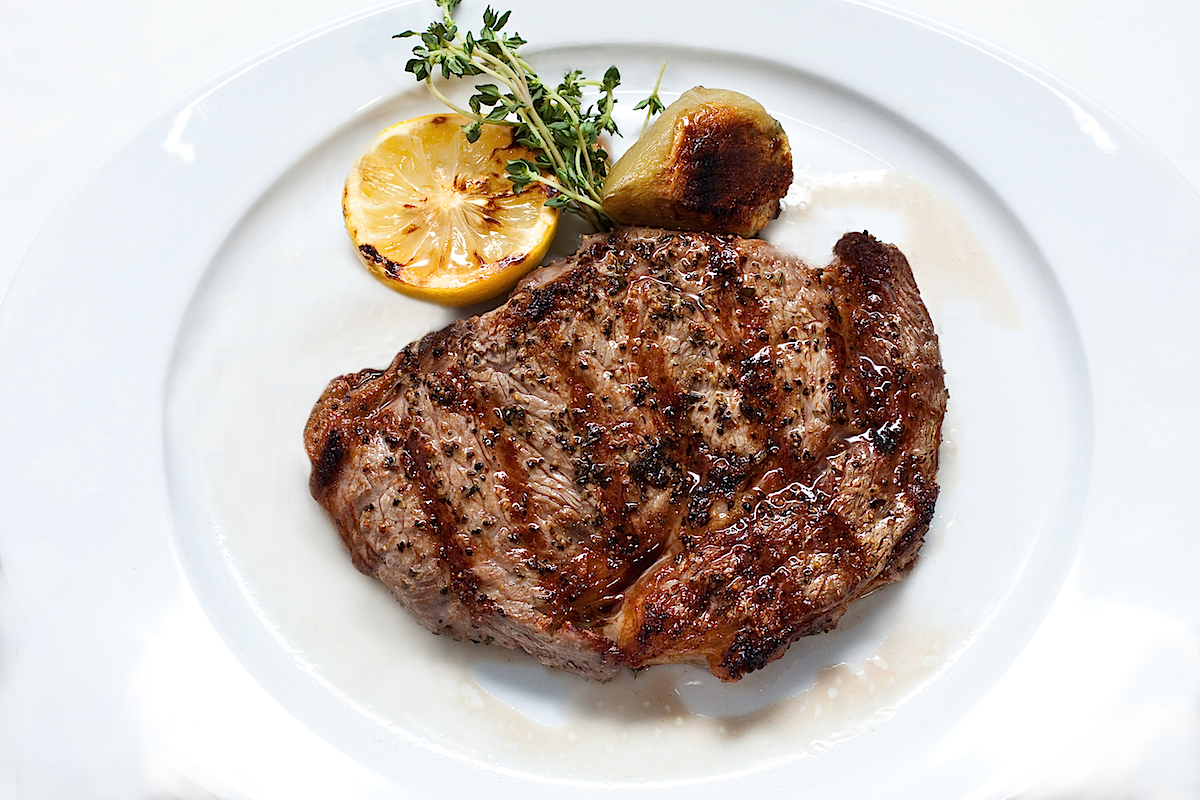 red
within.
red
within.
The menu lists the usual sides, like
spinach with garlic or mascarpone (take the
latter) and truffled French fries--all a steep $14
a piece, especially since uptown competitors like
Davio’s charges $10-$12, and Charlie Palmer
$9-$11.
Not unlike the dated desserts at the
original Il Mulino, those at Prime should be more
than run-of-the-mill. Limoncello
tiramisù was poor and the tartufo ice cream ball
as horrible as it ever was.
Il Mulino Prime’s wine list is amenable to
the restaurant’s genre of restaurant, and there
are some judicious selections below $50.
It
is curious that Il Mulino Prime is one of the
first steakhouses to debut in this neck of the
Manhattan woods, where new hipster places are
opening right and left of it all the time. So, if
you choose wisely--and bring a wad of money or
expense account plastic--you’ll satisfy your
craving for Prime beef here in a room that shows
you can cut across the grain.
❖❖❖
NEW MEXICAN SPARKLER
By Andrew Chalk
 Gruet
Winery this year celebrates twenty
five years in New Mexico since the release of
their very first wine. The Gruet family is
mighty proud and they have every right to be. In
that short quarter-century the winery has won
countless awards across the United States and
Europe, achieved distribution in 49 states as
well as Japan and Nassau-Bahamas and has
received critical acclaim in all of the wine
tasting publications. It now produces around
130,000 cases of wine a year, making it a
medium-sized winery on the global map.
Gruet
Winery this year celebrates twenty
five years in New Mexico since the release of
their very first wine. The Gruet family is
mighty proud and they have every right to be. In
that short quarter-century the winery has won
countless awards across the United States and
Europe, achieved distribution in 49 states as
well as Japan and Nassau-Bahamas and has
received critical acclaim in all of the wine
tasting publications. It now produces around
130,000 cases of wine a year, making it a
medium-sized winery on the global map.
Gruet
has not just put their family on the map as a
sparkling wine producer in the Champagne style.
They have single-handedly put New Mexico on the
map as a state capable of growing world-class
grapes. In fact, the state has an expanding wine
industry, now over 50 wineries, producing better
wine every year. While no other state wineries
have yet emerged on the national stage, Gruet
silences critics who might otherwise say that is
impossible for a New Mexico winery using New
Mexico grapes to do so.
It is instructive to see how Gruet got
where it is today. The founder, Gilbert Gruet, was
something of an entrepreneur. In the hardscrabble
years after World War Two in France, he saw an
opportunity to make money making Champagne by
growing and sourcing grapes from the southern part
of the Champagne region. Purists scoffed at
growing grapes in that part of Champagne, but he
persisted and quickly rode the growing demand for
Champagne that followed postwar prosperity.
Initially, he founded and participated in the
local grower cooperative but in 1967 founded G.
Gruet et Fils to make and brand his
own product.
His evangelism on behalf of his wines took
him on sales tours of the United States, where he
was profoundly moved by the open space and the
business opportunities. Land was just a fraction
of the price in France, and he believed the
climate for grape growing often better. The 1980s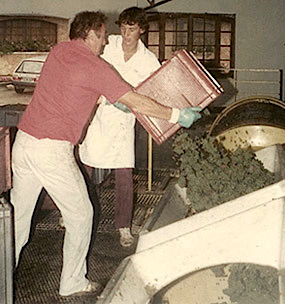 was a
time when many Champagne houses set up shop in
America. The list, including Moët et Chandon,
Mumm, and Roederer, was a cavalcade of top names,
but they all went to California.
was a
time when many Champagne houses set up shop in
America. The list, including Moët et Chandon,
Mumm, and Roederer, was a cavalcade of top names,
but they all went to California.
Gruet, as of 1952, carved his
own course.
He took his son, Laurent, and his daughter,
Nathalie, to help him plant grapes in southern New
Mexico near the town of Lordsburg. Aside from the
problems of dust storms, incredible heat,
rattlesnakes and tarantulas, the children did not
speak English. While at the vineyards, they stayed
in two trailer homes next to the fields. The whole
scene in the New Mexico desert was in stark
contrast to their family home back in benign and
verdant temperate northern France.
In 1988 they moved the vineyard north near
the town of Truth or Consequences, where the soil
was better and the altitude higher. At 4.300 feet
above sea level, it is one of the highest
vineyards in the United States. The altitude meant
diurnal shifts of 30 degrees between day and
night, enabling the grapes to cool and take longer
for the sugars to rise to ripeness levels. That
extra time allowed the grapes to achieve full
phenolic ripeness, not just ripe sugar levels.
Gruet has 350 acres in the area (and now also
boasts the spaceport of Virgin Galactic) .
The first harvest was in 1987 and the first
wine release in 1989, Gruet Brut N.V and Gruet
Blanc de Noirs, N.V. As Laurent remembers, it was
scary to have 80,000 bottles of wine in the
warehouse and no buyers. However, he entered them
in one of the country’s toughest wine shows, the
San Francisco International Wine Competition, and
brought back two medals.
With the population of all New Mexico less
than that of Dallas-Fort Worth, big sales had to
come from outside the state. That meant
distribution was key. An early adopter was
Monterey Bay Wine Company in the person of Joe Kimbro.
After tasting the wines, he ordered 50 cases - a
huge order for that stage in Gruet’s life. In the
far larger New York market, respected California
winemaker Randall Grahm of Bonny Doon Vineyard)
recommended the wine to Michael Skurnik of Michael
Skurnik Wines, and an http://www.skurnikwines.com/msw/about.html> order of 900 cases followed
shortly. It
sold out so quickly they had to air ship the next
order in.
With
the passing of Gilbert suddenly in 1999 control
passed to Laurent who maintained his father’s
outward-looking perspective. Today, Gruet is a
familiar label in fine wine stores and
supermarkets. As demand has grown, they have
raised their prices and created a second label Domaine
Saint-Vincent for the banquet hall market. They
have also have had to source some grapes from
outside New Mexico (Washington State and Lodi,
California) as they wait for additional plantings
to come on line. They are already sourcing from
another New Mexico grower in the Deming area and
have a long-term vineyard project with the Santa
Ana Pueblo. In
that thirty acre plot, are plantings of the Pinot
Meunier, a grape
variety widely used in Champagne.
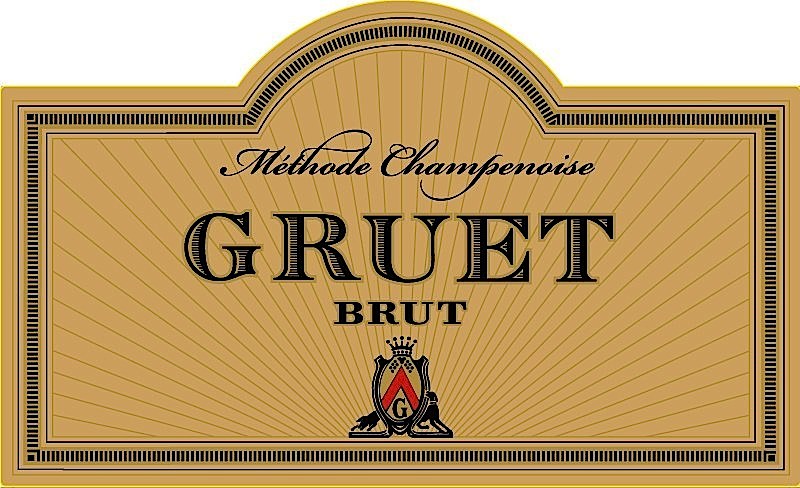 They have
broadened the product line as well. There is now a
set of vintage sparkling wines, a reserve tier,
and still wines made from Pinot Noir and Syrah. In
fact, still wines now account for 20% of total
output. The
non-vintage wines, Brut and Blanc de Noirs, have
sales levels that require the use of the
out-of-state grapes. Hence, the ‘American’
appellation has replaced the ‘New Mexico’
appellation on the label.
They have
broadened the product line as well. There is now a
set of vintage sparkling wines, a reserve tier,
and still wines made from Pinot Noir and Syrah. In
fact, still wines now account for 20% of total
output. The
non-vintage wines, Brut and Blanc de Noirs, have
sales levels that require the use of the
out-of-state grapes. Hence, the ‘American’
appellation has replaced the ‘New Mexico’
appellation on the label.
There
was
a hiccup in 2011 when Laurent Gruet bid for
bankrupt Cap Rock Winery of Lubbock at auction but
then failed to follow through. A suit by the
bankruptcy trustee led to Laurent filing personal
bankruptcy (the winery did not file for bankruptcy
protection and was not part of the bid for Cap
Rock). Eventually the trustee’s suit was settled."
The
vintage wines all carry New Mexico appellations,
meaning at least 75% New Mexico fruit. At a
tasting at the winery I worked my way through the
2010 Blanc
de Blancs, the 2010 Grande
Rosé and the 2007 Grande
Reserve. The vintage wines have more
intensity of flavors and, as they get older,
acquire the characteristic yeastiness of aged
Champagne so prized by collectors, particularly in
the U.K. The Grande Reserves are all fermented and
aged in French oak, promoting vanilla and
autolyzed flavors. Placing Gruet in the
Champagne style spectrum is fairly
straightforward. The reserves are heavier than the
light, fresh, style of Perrier-Jouët, but lighter
than the imposing presence of Krug. The middle
position between these two, perhaps a touch closer
to Krug, would be right. Perhaps the Charles
Heidsieck typifies this.
In celebration of the 25th anniversary, the
winery has produced the NV Blanc de
Blancs 25th Anniversary wine. They suggest
that you think of it as the little brother of the
vintage Blanc de Blancs. I agree, and look forward
to the 50th anniversary of this remarkable winery.
For a complete
list of New Mexican wineries and map, go to http://www.nmwine.com
❖❖❖
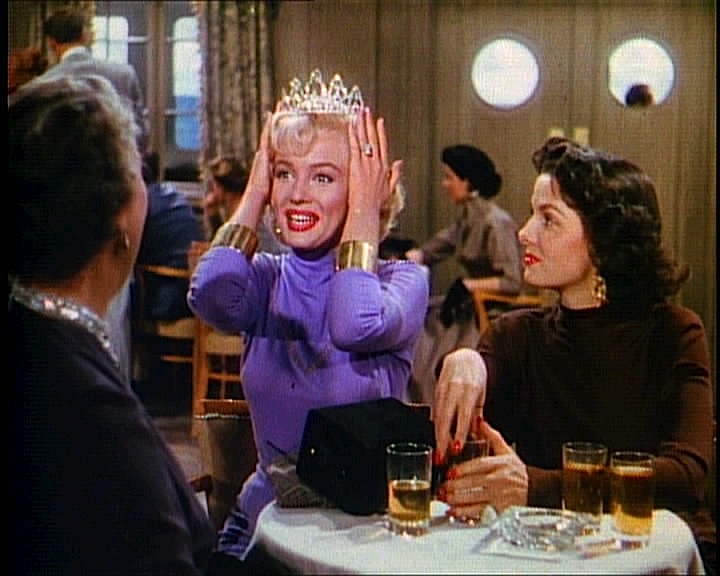 Forgive
Her Such Prose: Her Parents Named her Bambi
Forgive
Her Such Prose: Her Parents Named her Bambi
"Well! Perhaps `Posh
Diner' would accuse me of NOT being posh. I say wake
up and smell the coffee, lambchop. This place is
fabulous. They have a very current bar (I had a Grey
Goose). Then I went and had a delicious dinner - the
Octopus appetizer was sensational baby, and the
truffle mac and cheese was not your blue box Kraft.
I was left absolutely stunned. I walked in without a
reservation, but perhaps my attire, bling, Ostrich
stilettos, and spritz of Glow perfume rolled the red
carpet out. If you're fabulous and you know it clap
your hands. I flirted, fed, and finally left utterly
satisfied. The busboys were a little anxious about
taking plates, but this woman over 50 has cougar
instincts that tell her they just wanted to be
close."—Bambi Ambrosino, "Waverly Inn," Menu Pages.
NEXT SEASON THEY'RE MAKING
CHINESE NOODLES
WITH
MAO TSE TUNG ON THE PACKAGE
Zurich-based
retailer Migros has recalled several thousand
mini-creamer packages that were issued to
commemorate a cigar band series that once used
portraits of Hitler and Mussolini on them.
Production of all dictator lids has been
halted.
A BIG ANNOUNCEMENT!
 I'm proud and
happy to announce that my new book, The
Hound in Heaven (21st Century Lion
Books), has just been published through Amazon
and Kindle. It is a Christmas novella,
and for anyone who loves dogs, Christmas, romance,
inspiration, even the supernatural, I hope you'll
find this to be a treasured favorite. The
story concerns how, after a New England teacher, his
wife and their two daughters adopt a stray puppy
found in their barn in northern Maine, their lives
seem full of promise. But when tragedy strikes,
their wonderful dog Lazarus and the spirit of
Christmas are the only things that may bring back
his master back from the edge of despair.
I'm proud and
happy to announce that my new book, The
Hound in Heaven (21st Century Lion
Books), has just been published through Amazon
and Kindle. It is a Christmas novella,
and for anyone who loves dogs, Christmas, romance,
inspiration, even the supernatural, I hope you'll
find this to be a treasured favorite. The
story concerns how, after a New England teacher, his
wife and their two daughters adopt a stray puppy
found in their barn in northern Maine, their lives
seem full of promise. But when tragedy strikes,
their wonderful dog Lazarus and the spirit of
Christmas are the only things that may bring back
his master back from the edge of despair.
“What a huge surprise turn this story took! I was completely stunned! I truly enjoyed this book and its message.” – Actress Ali MacGraw
“He had me at Page One. The amount of heart, human insight, soul searching, and deft literary strength that John Mariani pours into this airtight novella is vertigo-inducing. Perhaps ‘wow’ would be the best comment.” – James Dalessandro, author of Bohemian Heart and 1906.
“John Mariani’s Hound in Heaven starts with a well-painted portrayal of an American family, along with the requisite dog. A surprise event flips the action of the novel and captures us for a voyage leading to a hopeful and heart-warming message. A page turning, one sitting read, it’s the perfect antidote for the winter and promotion of holiday celebration.” – Ann Pearlman, author of The Christmas Cookie Club and A Gift for my Sister.
“John Mariani’s concise, achingly beautiful novella pulls a literary rabbit out of a hat – a mash-up of the cosmic and the intimate, the tragic and the heart-warming – a Christmas tale for all ages, and all faiths. Read it to your children, read it to yourself… but read it. Early and often. Highly recommended.” – Jay Bonansinga, New York Times bestselling author of Pinkerton’s War, The Sinking of The Eastland, and The Walking Dead: The Road To Woodbury.
“Amazing things happen when you open your heart to an animal. The Hound in Heaven delivers a powerful story of healing that is forged in the spiritual relationship between a man and his best friend. The book brings a message of hope that can enrich our images of family, love, and loss.” – Dr. Barbara Royal, author of The Royal Treatment.
Any of John Mariani's
books below may be ordered from amazon.com.
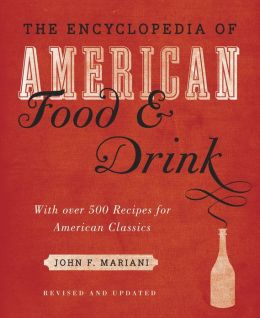 |
The Encyclopedia of American Food and Drink by John F. Mariani (Bloomsbury USA, $35) Modesty forbids me to praise my own new book, but let me proudly say that it is an extensive revision of the 4th edition that appeared more than a decade ago, before locavores, molecular cuisine, modernist cuisine, the Food Network and so much more, now included. Word origins have been completely updated, as have per capita consumption and production stats. Most important, for the first time since publication in the 1980s, the book includes more than 100 biographies of Americans who have changed the way we cook, eat and drink -- from Fannie Farmer and Julia Child to Robert Mondavi and Thomas Keller. "This book is amazing! It has entries for everything from `abalone' to `zwieback,' plus more than 500 recipes for classic American dishes and drinks."--Devra First, The Boston Globe. "Much needed in any kitchen library."--Bon Appetit. |
"Eating Italian will never be the same after reading John Mariani's entertaining and savory gastronomical history of the cuisine of Italy and how it won over appetites worldwide. . . . This book is such a tasteful narrative that it will literally make you hungry for Italian food and arouse your appetite for gastronomical history."--Don Oldenburg, USA Today. "Italian
restaurants--some good, some glitzy--far
outnumber their French rivals. Many of
these establishments are zestfully described
in How Italian Food Conquered the World, an
entertaining and fact-filled chronicle by
food-and-wine correspondent John F.
Mariani."--Aram Bakshian Jr., Wall Street
Journal.
"Equal parts
history, sociology, gastronomy, and just
plain fun, How Italian Food Conquered the
World tells the captivating and delicious
story of the (let's face it) everybody's
favorite cuisine with clarity, verve and
more than one surprise."--Colman Andrews,
editorial director of The Daily
Meal.com. "A fantastic and fascinating
read, covering everything from the influence
of Venice's spice trade to the impact of
Italian immigrants in America and the
evolution of alta cucina. This book will
serve as a terrific resource to anyone
interested in the real story of Italian
food."--Mary Ann Esposito, host of PBS-TV's
Ciao
Italia. "John Mariani has written the
definitive history of how Italians won their
way into our hearts, minds, and
stomachs. It's a story of pleasure over
pomp and taste over technique."--Danny Meyer,
owner of NYC restaurants Union Square
Cafe, The Modern, and Maialino.
|
 |
 |
 |
 |
 |
 |
 |
 |
 Everett Potter's Travel Report:
Everett Potter's Travel Report: 
 Eating Las Vegas
is the new on-line site for Virtual Gourmet
contributor John A. Curtas., who since 1995
has been commenting on the Las Vegas food
scene and reviewing restaurants for Nevada
Public Radio. He is also the
restaurant critic for KLAS TV, Channel 8 in
Las Vegas, and his past reviews can be
accessed at KNPR.org.
Click on the logo below to go directly to
his site.
Eating Las Vegas
is the new on-line site for Virtual Gourmet
contributor John A. Curtas., who since 1995
has been commenting on the Las Vegas food
scene and reviewing restaurants for Nevada
Public Radio. He is also the
restaurant critic for KLAS TV, Channel 8 in
Las Vegas, and his past reviews can be
accessed at KNPR.org.
Click on the logo below to go directly to
his site.

Tennis Resorts Online: A Critical Guide to the World's Best Tennis Resorts and Tennis Camps, published by ROGER COX, who has spent more than two decades writing about tennis travel, including a 17-year stretch for Tennis magazine. He has also written for Arthur Frommer's Budget Travel, New York Magazine, Travel & Leisure, Esquire, Money, USTA Magazine, Men's Journal, and The Robb Report. He has authored two books-The World's Best Tennis Vacations (Stephen Greene Press/Viking Penguin, 1990) and The Best Places to Stay in the Rockies (Houghton Mifflin, 1992 & 1994), and the Melbourne (Australia) chapter to the Wall Street Journal Business Guide to Cities of the Pacific Rim (Fodor's Travel Guides, 1991).


MARIANI'S VIRTUAL GOURMET
NEWSLETTER is published weekly. Editor/Publisher: John
Mariani.
Editor: Walter Bagley. Contributing Writers: Christopher Mariani,
Robert Mariani, Misha
Mariani,
John A. Curtas, Edward Brivio, Mort Hochstein,
Andrew Chalk, Dotty Griffith and Brian Freedman. Contributing
Photographers: Galina Dargery, Bobby
Pirillo. Technical Advisor: Gerry McLoughlin.
To un-subscribe from this newsletter,click here.
© copyright John Mariani 2014

